

Calendar. One account.

All of Google. Sign in to continue to Google Calendar Find my account Forgot password? KITP Miniprogram: Quantitative Immunology: Experiments Meet Modeling. Complex Spatial Dynamics of Oncolytic Viruses In Vitro: Mathematical and Experimental Approaches. Results Experimentally observed patterns of virus spread In order to examine spatial virus spread in a relatively simple setting, we constructed a recombinant adenovirus type-5 (Ad5) that expresses enhanced jellyfish green fluorescent protein (EGFP), AdEGFPuci, and grows on human 293 embryonic kidney epithelial (293) cells [39].

The experiment was set up such that cells are arranged in a two-dimensional layer, and virus spread is most likely to occur to neighboring cells. An agar overlay prevents long-range spread of the virus away from infected cells in the culture medium. Papers. Methods for Detecting Early Warnings of Critical Transitions in Time Series Illustrated Using Simulated Ecological Data. Many dynamical systems, including lakes, organisms, ocean circulation patterns, or financial markets, are now thought to have tipping points where critical transitions to a contrasting state can happen. Because critical transitions can occur unexpectedly and are difficult to manage, there is a need for methods that can be used to identify when a critical transition is approaching. Recent theory shows that we can identify the proximity of a system to a critical transition using a variety of so-called ‘early warning signals’, and successful empirical examples suggest a potential for practical applicability.
However, while the range of proposed methods for predicting critical transitions is rapidly expanding, opinions on their practical use differ widely, and there is no comparative study that tests the limitations of the different methods to identify approaching critical transitions using time-series data. Figures Copyright: © 2012 Dakos et al. Introduction Table 1. Figure 1. Figure 2. Detecting early-warning signals for sudden deterioration of complex diseases by dynamical network biomarkers. Quantifying limits to detection of early warning for critical transitions. + Author Affiliations ↵*Author for correspondence (cboettig@ucdavis.edu). Abstract Catastrophic regime shifts in complex natural systems may be averted through advanced detection. Recent work has provided a proof-of-principle that many systems approaching a catastrophic transition may be identified through the lens of early warning indicators such as rising variance or increased return times.
Despite widespread appreciation of the difficulties and uncertainty involved in such forecasts, proposed methods hardly ever characterize their expected error rates. 1. Observations on cyanobacterial population collapse in eutrophic lake water. On the spontaneous emergence of cell polarity : Abstract : Nature. Untitled. Untitled. Early Warning Signals for Critical Transitions: A Generalized Modeling Approach. Early Warning Signals for Critical Transitions: A Generalized Modeling Approach. Abstract Critical transitions are sudden, often irreversible, changes that can occur in a large variety of complex systems; signals that warn of critical transitions are therefore highly desirable.
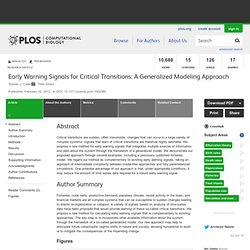
We propose a new method for early warning signals that integrates multiple sources of information and data about the system through the framework of a generalized model. We demonstrate our proposed approach through several examples, including a previously published fisheries model. We regard our method as complementary to existing early warning signals, taking an approach of intermediate complexity between model-free approaches and fully parameterized simulations. Indicators of regime shifts – potential uses in medicine « Computers, Society, and Nature.
I attended Steve Carpenter’s lecture on Indicators of regime shifts, and was intrigued by the possibility of using those same indicators in medicine.
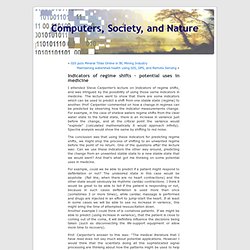
The lecture went to show that there are some indicators which can be used to predict a shift from one stable state (regime) to another. Prof. Carpenter commented on how a change in regimes can be predicted by observing how the indicator measurements change. For example, in the case of shallow waters regime shifts from the clear water state to the turbid state, there is an increase in variance just before the change, and at the critical point the variance would “explode” (calculated mathematically it would approach infinity). Practical Methods for Analysis of Early-Warnings for Regime Shifts" This is a joint ASU-SFI working group.
Working Group October 10, 2011 - October 12, 2011 Noyce Conference Room Much of the research on early-warning signals is still under development with new ideas constantly arising.
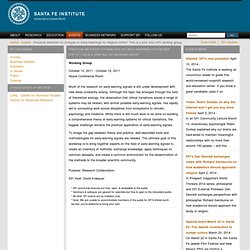
Although the topic has emerged through the field of theoretical ecology, the observation that critical transitions across a range of systems may be related, with similar possible early-warning signals, has rapidly led to connecting work across disciplines from ecosystems to climate, psychology and medicine. While there is still much work to be done on building a comprehensive theory of early-warning systems for critical transitions, the biggest challenge remains the practical application of early-warning signals. To bridge the gap between theory and practice, well-described tools and methodologies for early-warning signals are needed. Purpose: Research Collaboration SFI Host: David Krakauer. Early warning signal for ecosystem collapse: Fluctuations before the fall. Researchers eavesdropping on complex signals emanating from a remote Wisconsin lake have detected what they say is an unmistakable warning -- a death knell -- of the impending collapse of the lake's aquatic ecosystem.
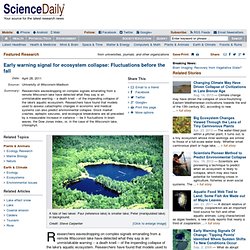
Researchers have found that models used to assess catastrophic changes in economic and medical systems can also predict environmental collapse. Stock market crashes, epileptic seizures, and ecological breakdowns are all preceded by a measurable increase in variance—be it fluctuations in brain waves, the Dow Jones index, or, in the case of the Wisconsin lake, chlorophyll. The finding, reported April 29 in the journal Science by a team of researchers led by Stephen Carpenter, a limnologist at the University of Wisconsin-Madison, is the first experimental evidence that radical change in an ecosystem can be detected in advance, possibly in time to prevent ecological catastrophe. The implications of the National Science Foundation-supported study are big, says Carpenter.
Early warnings of regime shifts in spatial dynamics using the discrete Fourier transform. Trends in Ecology & Evolution - Catastrophic regime shifts in ecosystems: linking theory to observation. To view the full text, please login as a subscribed user or purchase a subscription.

Click here to view the full text on ScienceDirect. Figure 1 The collapse of Saharan vegetation as an example of an ancient regime shift. After millennia of fluctuations around a smoothly decreasing trend of vegetation cover, an abrupt collapse over the Sahara occurred between 5000 and 6000 years ago, as reflected in the contribution of terrigenous dust (axis reversed) to oceanic sediment at a sample site near the African coast. Modified with permission from [61] . Figure 2. Regime shift.
In ecology, regime shifts are large, abrupt, persistent changes in the structure and function of a system.[1] A regime is a characteristic behaviour of a system which is maintained by mutually reinforced processes or feedbacks.

Regimes are considered persistent relative to the time period over which the shift occurs. The change of regimes, or the shift, usually occurs when a smooth change in an internal process (feedback) or a single disturbance (external shocks) triggers a completely different system behavior.[2][3][4][5] Although such non-linear changes have been widely studied in different disciplines ranging from atoms to climate dynamics,[6] regime shifts have gained importance in ecology because they can substantially affect the flow of ecosystem services that societies rely upon,[7][8] such as provision of food, clean water or climate regulation. History of the concept[edit] Ecological Modelling - Catastrophe theory in ecology: a critical review and an example of the butterfly catastrophe.
Catastrophe theory is no longer new but it remains controversial.

Controversy arises not out of the mathematical foundations of the theory nor from applications in the hard sciences, but principally when it is applied to the social and biological sciences. Error catastrophe. Error catastrophe is the extinction of an organism (often in the context of microorganisms such as viruses) as a result of excessive mutations.
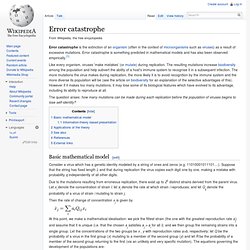
Error catastrophe is something predicted in mathematical models and has also been observed empirically.[1] Like every organism, viruses 'make mistakes' (or mutate) during replication. The resulting mutations increase biodiversity among the population and help subvert the ability of a host's immune system to recognise it in a subsequent infection. The more mutations the virus makes during replication, the more likely it is to avoid recognition by the immune system and the more diverse its population will be (see the article on biodiversity for an explanation of the selective advantages of this).
However if it makes too many mutations, it may lose some of its biological features which have evolved to its advantage, including its ability to reproduce at all. Numerical Integration of the Master Equation in Some Models of Stochastic Epidemiology. The processes by which disease spreads in a population of individuals are inherently stochastic. The master equation has proven to be a useful tool for modeling such processes. Unfortunately, solving the master equation analytically is possible only in limited cases (e.g., when the model is linear), and thus numerical procedures or approximation methods must be employed.
Available approximation methods, such as the system size expansion method of van Kampen, may fail to provide reliable solutions, whereas current numerical approaches can induce appreciable computational cost. In this paper, we propose a new numerical technique for solving the master equation. Master equation. In physics and chemistry and related fields, master equations are used to describe the time-evolution of a system that can be modelled as being in exactly one of countable number of states at any given time, and where switching between states is treated probabilistically. The equations are usually a set of differential equations for the variation over time of the probabilities that the system occupies each different states. Introduction[edit] where. Dr. Andrew X. Black.
Google Image Result for. T Cell Development. Computational Biology » Center for Information and Systems Engineering. Kick off meeting for Y. Paschalidis research grant. CISE Faculty: Calin Belta, Ioannis Paschalidis and Sandor Vajda. A bacterial cell receives several inputs from its environment, including the availability of different nutrients and the ambient temperature and pH. Based on these inputs, a bacterium controls its growth rate and molecular composition, which can be thought of as the output of the system. By combining experimental measurements and mathematical models, Paschalidis and Segre aim to gradually dcode this input-output relationship and thereby predict the output given the input or vice versa, enabling researchers to track the source of potential pathogens.
Research Spotlight: CSR <span id="Postingname3_PostingDisplayName">Modeling and Analysis of Biological Systems Study Section [MABS]</span> (BSTIRG) Biomedical Information Science and Technology Initiative (BISTI) NCBI CBB Home. Cytotoxic T Cells. Production of antigen receptors. T Cell Development. T-Cell Education.avi.